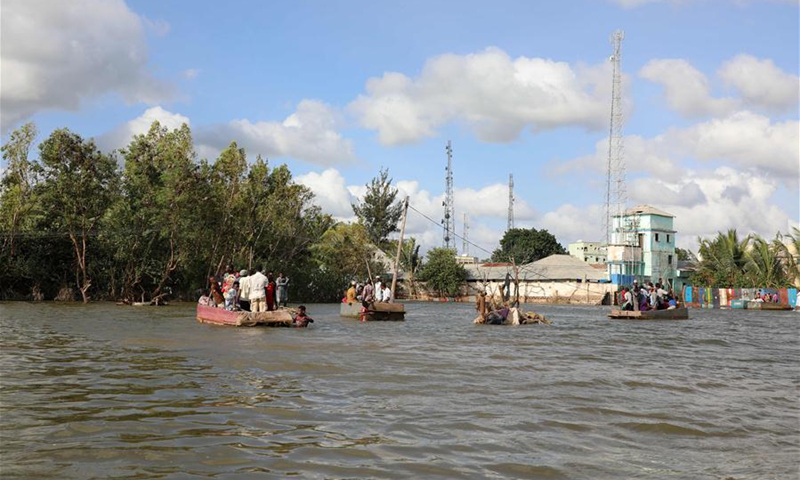COMMENTS / EXPERT ASSESSMENT
The US’ ‘foreign assistance’ has lost popularity

People row through a flooded road in Afgoye, Somalia, Aug. 9, 2020. (Photo by Hassan Bashi/Xinhua)
A former director of the Office of Foreign Assistance at the US State Department recently published an article rethinking the US' foreign assistance which he believed has fallen behind China.
"The Chinese are relevant," Jim Richardson wrote on the US news outlet Foreign Policy. He added that China succeeds in large part because it offers developing countries what they actually want. The US, on the other hand, hamstrings itself because its foreign assistance often comes late and for the wrong thing.
The article represents a rare self-criticism of the US on its foreign assistance since the end of the Cold War. It shows that the development assistance of the US has deviated from the original aim of empowering global development governance and has long been unpopular in developing countries.
Firstly, the US identified the root cause of poverty in developing countries as poorly run institutions, showing a skewed perception over development. During the Cold War, the US, driven by geopolitical rivalry agenda, injected a large amount of development capital into the "middle zone" such as Africa, and helped African countries to achieve national independence and development from being colonized. But the collapse of the Soviet Union eliminated the need for the US to make additional effort to enlist the support of developing countries.
Hence, from previous US Presidents George H. W. Bush to Bill Clinton, their administrations largely turned a blind eye toward Africa. Though later Clinton administration had to resume foreign aid efforts in order to revert a collapsing international image of the US, their "effort" did not include a fundamental development philosophy and could not generate any practical experience for others. Instead, they adopted an approach taken by the World Bank and other development banks. When the countries face repayment difficulties or a balance-of-payments crisis, these institutions would require them to launch institutional adjustments, including reforms of reducing spending, lowering taxes, loosening regulation or privatization. To this end, the US has begun to stress that institutional reform is the key to boosting growth. However, their dogmatic "guidance" could not address the imminent problems of most low- and middle-income countries.
Moreover, the US has overly focused on military intervention during providing humanitarian assistance. It is often the case that humanitarian aid is used as a tool to advertise American values to foreign countries, and whitewash its national image. If the US aggressively initiates a rivalry with China for influence over the rest of the world, humanitarian aid would appear to be a advantageous "battlefield" for the US, since relying on its global deployment capacity of the US military, the hegemonic power can swiftly intervene in any outbreak of humanitarian disasters.
However, the arrogant US has lost sight of the root causes of the crisis - poverty and poor development outcomes are breeding grounds for terrorism, while economic growth and prosperity are essential vanguards for peace. Simply using the military intervene to resolve problems without a focus on reconstruction will only end up in failure. Meanwhile China is pursuing a path of exploration to achieve growth, offering accelerating facilitation to developing countries in infrastructure advancement through Belt and Road Initiative and Asian Infrastructure Investment Bank.
In addition, the US has over time created a highly complicated and inefficient process of approving, procuring and evaluating any foreign aid projects, yielding to procedural justice. The US has nearly twice as many foreign diplomats as China, spends 10 times as much on foreign aid as China; however, it has a huge gap in aid effectiveness comparing to China. Taking the African countries as an example, the continent in 1990s and 2000s was plagued by low per capita growth rate, even registered negative growth constantly, dragging the continent behind other regions.
An important reason for this is that the US foreign aid decision-making system is too bulky and no longer fit for purpose, paralyzed by excessive administrative costs to ensure procedural justice, and the ultimate "payer" can only be the aid recipient country.
If the US intends to compete with China when it comes to influence in the developing world, it must respect the political choices of the local governments, make meaningful choices to actually improve the livelihoods of ordinary people in recipient countries by supporting tangible projects such as dams, power grids, drainage systems, education, and urban infrastructure.
The author is a research fellow at the Chinese Academy of International Trade and Economic Cooperation. bizopinion@globaltimes.com.cn



